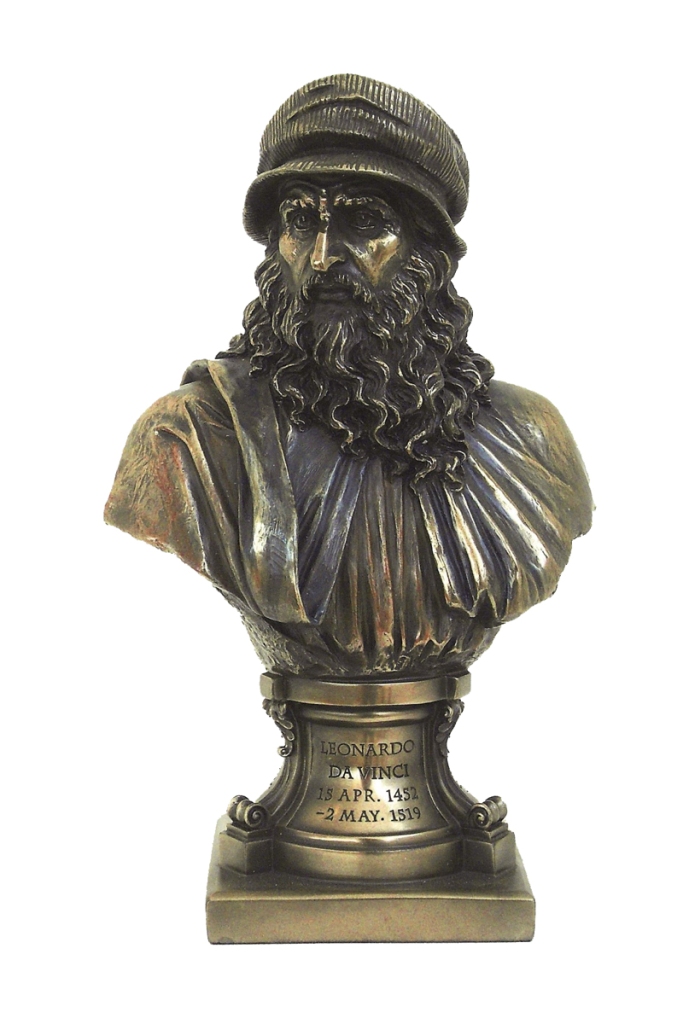Leonardo Da Vinci “Renaissance Man” Bust Statue
Leonardo has often been described as the archetype of the Renaissance Man, a man of “unquenchable curiosity” and “feverishly inventive imagination“, and epitomiz the Renaissance humanist ideal. This Leonardo Da Vinci Bust Statue features a wonderful metallic bronze finish that gives it the look of look of metal, and has hand painted accents to show the incredible detail. It makes a great gift for any classical art lover. Leonardo di ser Piero da Vinci, known simply as Leonardo da Vinci (Anchiano, April 15, 1452 – Amboise, May 2, 1519), was an Italian scientist, inventor and artist. A man of genius and universal talent of the Renaissance, considered one of the greatest geniuses of humanity, he fully embodied the spirit of his era, bringing it to the greatest forms of expression in the most disparate fields of art and knowledge: he was in fact a scientist, philosopher, architect, painter, sculptor, draftsman, essayist, set designer, mathematician, anatomist, botanist, musician, engineer and designer.
«Fu tanto raro e universale, che dalla natura per suo miracolo esser produtto dire si puote: la quale non solo della bellezza del corpo, che molto bene gli concedette, volse dotarlo, ma di molte rare virtù volse anchora farlo maestro. Assai valse in matematica et in prospettiva non meno, et operò di scultura, et in disegno passò di gran lunga tutti li altri. Hebbe bellissime inventioni, ma non colorì molte cose, perché si dice mai a sé medesimo avere satisfatto, et però sono tante rare le opere sue. Fu nel parlare eloquentissimo et raro sonatore di lira, et fu valentissimo in tirari et in edifizi d’acque, et altri ghiribizzi, né mai co l’animo suo si quietava, ma sempre con l’ingegno fabricava cose nuove». Anonimo Gaddiano. **(Language: Renaissance Italian).
«It was so rare and universal, that by its miracle it could be said that nature was produced: she not only wanted to endow it with the beauty of the body, which she very well granted it, but also wanted to make it a master of many rare virtues. He was very valuable in mathematics and in perspective no less, and he worked in sculpture, and in drawing he passed by far all the others. He had beautiful inventions, but he did not color many things, because he himself is never said to be satisfied, and yet his works are so rare. He was in speaking eloquent and rare lyre player, and he was very skilful in tirari and in water buildings, and other whims, never calmed down with his soul, but always with his ingenuity he built new things». Anonymous Gaddiano, manuscript of the National Central Library of Florence (XVII, 17th century).
The features of Leonardo are known thanks to a senile self-portrait attributed to him, dating back to around 1515 and preserved in the Royal Library of Turin. The work, from which other ideal portraits derive, is now part of the collective imagination. For the features of Leonardo at a young or mature age there are some hypotheses of identification, in his works or by other artists, as in the young man standing at the extreme right of the Adoration of the Magi, in Verrocchio‘s David or in the figure of Plato in the Raphael‘s School of Athens. There are also various sources which, even without describing his physical appearance in a precise way, speak of his ways and celebrate his beauty. For example, the Anonymous Gaddiano wrote: “Nature not only wanted to endow him with the beauty of the body, which he very well granted him, but also wanted to make him a master of many rare virtues. He was of a good person, proportionata, gratiata and handsome in appearance. He wore a pink bitch that was short up to the knee, which was then used in long dresses, he had a beautiful, ringed and well composed headdress up to the middle on his chest”.
Vasari instead caught the docile and loving aspect of his character:
«Egli con lo splendor dell’aria sua, che bellissima era, rasserenava ogni animo mesto, e con le parole volgeva al sì et al no ogni indurata intenzione. Egli con le forze sue riteneva ogni violenta furia. Con la liberalità sua raccoglieva e pasceva ogni amico povero e ricco, pur che egli avesse ingegno e virtù. Per il che ebbe veramente Fiorenza grandissimo dono nel nascere di Lionardo, e perdita più che infinita nella sua morte». **(Language: Renaissance Italian).
«With the splendor of his air, how beautiful he was, he calmed every sad soul, and with his words he turned every hard intention to yes and no. He with his strength held every violent fury. With his liberality she gathered and fed every poor and rich friend, as long as he had talent and virtue. For which reason Fiorenza truly had a great gift in the birth of Lionardo, and a more than infinite loss in his death». Leonardo Da Vinci “Renaissance Man” Bust Statue sizes: 5.5 inches / 14 cm x 4.5 inches / 11.5 cm x 9 inches / 23 cm.
Leonardo Da Vinci Bust Statue on Amazon.
Leonardo Da Vinci Bust Statue on eBay.




You must be logged in to post a comment.